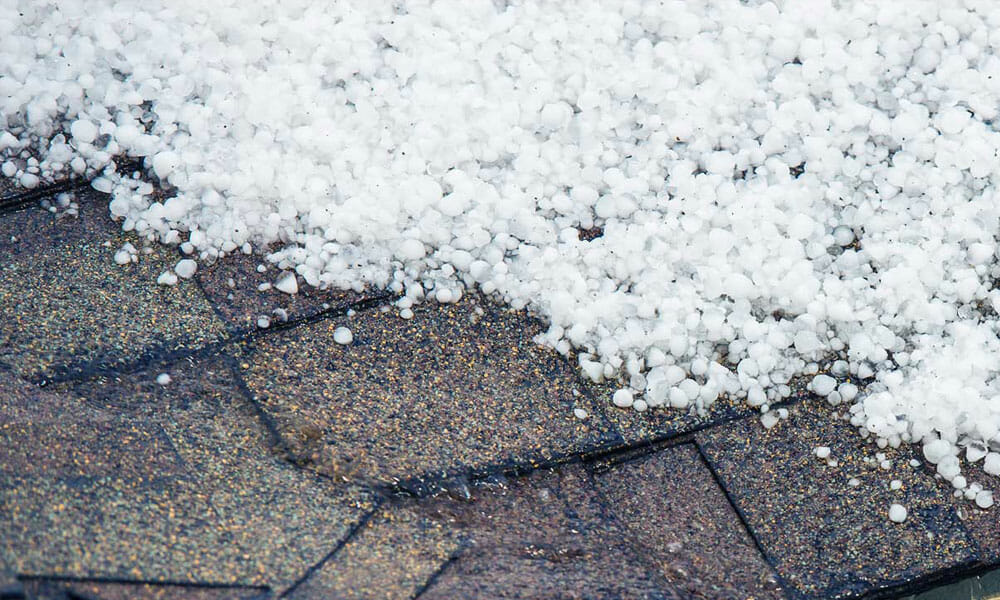The Impact Of Summer Hailstorms On Residential Landscapes

Table of Contents
Assessing the Damage After a Summer Hailstorm
Following a summer hailstorm, a thorough assessment of your residential landscape is crucial for effective repair and restoration. This involves evaluating the damage to different elements of your yard, from your lawn to your prized trees and delicate flowers.
Evaluating Lawn Damage:
Hail can bruise or destroy grass blades, leading to unsightly brown patches and overall lawn thinning. The extent of the damage depends heavily on the size and intensity of the hailstones.
- Look for discoloration: Brown or yellowed patches are a clear indication of hail damage.
- Check for flattened grass: Hail can literally flatten grass blades, leaving them lying limp and lifeless.
- Identify areas of significant damage: Some areas may be more severely affected than others, requiring more intensive repair.
Consider the size and intensity of the hailstones – larger hail causes more severe damage, potentially requiring more extensive lawn repair or even complete reseeding.
Inspecting Trees and Shrubs:
Trees and shrubs are particularly vulnerable to summer hailstorms. Hail can cause significant damage, impacting both their aesthetic appeal and long-term health.
- Check for broken branches: Large hailstones can easily snap branches, especially on younger or weaker trees.
- Examine leaves for damage: Hail can bruise or tear leaves, causing discoloration and premature leaf drop.
- Look for bark stripping: Severe hail can strip bark from trees, leaving them vulnerable to disease and pests.
- Assess overall plant health: Look for signs of stress, such as wilting or discoloration, beyond the immediate hail damage.
Young, tender plants are particularly vulnerable to hail damage, and may require more intensive care and attention to recover.
Examining Flowerbeds and Gardens:
Flowerbeds and vegetable gardens are often the most visibly affected areas after a hailstorm. Hailstones can bruise, break, or completely destroy flowers and vegetables.
- Inspect for damaged blooms: Petals can be torn or bruised, rendering flowers unsightly.
- Check for broken stems: Hail can snap stems, particularly on delicate flowers and young plants.
- Examine leaves for bruising: Bruised leaves may appear discolored or distorted.
Consider using protective coverings, such as netting or fabric, during severe weather forecasts to minimize damage to vulnerable plants.
Repairing Hail Damage to Your Residential Landscape
Repairing hail damage requires a systematic approach, tailored to the specific needs of your lawn, trees, shrubs, and flowerbeds. Patience and consistent care are essential for successful restoration.
Lawn Repair and Restoration:
Recovering your lawn after a hailstorm may involve several steps, depending on the severity of the damage.
- Reseeding: Severely damaged areas may require complete reseeding to establish new grass.
- Overseeding: For less severe damage, overseeding can help thicken and revitalize existing grass.
- Fertilization: Applying a balanced fertilizer can promote healthy growth and help your lawn recover quickly.
Consult a landscaping professional for advice tailored to your specific lawn type and the severity of the hail damage. Deep and regular watering is crucial for helping damaged grass recover.
Tree and Shrub Care Post-Hailstorm:
Providing proper care for your trees and shrubs after a hailstorm is essential for their long-term health and survival.
- Pruning damaged branches: Remove broken or damaged branches carefully using clean, sharp pruning shears to prevent further injury and disease.
- Wound dressing: Larger wounds may benefit from a tree wound dressing to protect against infection.
- Watering and fertilization: Provide adequate watering and fertilization to support recovery and new growth.
Consider applying fungicides or insecticides to prevent secondary infections or pest infestations that can exploit weakened plants.
Flowerbed and Garden Restoration:
Restoring your flowerbeds and garden after a hailstorm involves removing damaged plants and providing appropriate care for surviving plants.
- Remove damaged plants: Discard any plants that are beyond repair to prevent the spread of disease.
- Replace damaged plants: Replant with healthy seedlings or cuttings to restore the beauty of your garden.
- Mulching: Apply a layer of mulch to help retain moisture, suppress weeds, and protect plants from future damage.
Careful attention to detail and consistent care are vital for a successful garden restoration.
Preventing Future Hail Damage to Your Residential Landscape
While you can't control the weather, you can take steps to minimize the impact of future hailstorms on your residential landscape.
Protective Measures:
Implementing protective measures can significantly reduce the damage caused by hail.
- Hail nets: Consider installing hail nets over vulnerable plants, such as young trees or delicate flowers, to provide protection during storms.
- Temporary coverings: Use temporary coverings, such as tarps or row covers, to shield plants during severe weather forecasts.
Choose materials that are strong enough to withstand hail impact yet allow for adequate air circulation to prevent plant damage from overheating.
Landscape Design for Hail Resistance:
Strategic landscaping can enhance your property's resilience to hail damage.
- Hail-resistant plants: Choose plant varieties known for their resilience to hail damage. Consult your local nursery or extension service for recommendations.
- Lower-growing plants: Plant lower-growing shrubs and flowers to minimize the impact of hail.
- Strategic placement: Position vulnerable plants in sheltered areas of your yard, if possible.
By considering these factors, you can create a landscape that is better equipped to withstand the forces of nature.
Conclusion:
Summer hailstorms can inflict significant damage on residential landscapes, impacting your property's aesthetic appeal and requiring considerable repair efforts. By carefully assessing the damage, implementing appropriate repair strategies, and taking preventative measures, you can protect your investment and maintain a beautiful, healthy yard. Don't let summer hailstorms leave your landscape in ruins – take action today to understand the impact and take steps to protect and restore your property. Contact a qualified landscaping professional for advice on assessing and repairing hail damage to your residential landscape. Learn more about protecting your residential landscape from the impact of summer hailstorms and build a more resilient outdoor space.

Featured Posts
-
 Payton Pritchard Sixth Man Of The Year
May 12, 2025
Payton Pritchard Sixth Man Of The Year
May 12, 2025 -
 Avion Con Carga Inusual Uruguay Busca Mejorar Exportaciones Ganaderas A China
May 12, 2025
Avion Con Carga Inusual Uruguay Busca Mejorar Exportaciones Ganaderas A China
May 12, 2025 -
 Selena Gomez And Benny Blanco 10 Images Amidst Cheating Speculation
May 12, 2025
Selena Gomez And Benny Blanco 10 Images Amidst Cheating Speculation
May 12, 2025 -
 The Truth About Henry Cavills Superman Departure James Gunns Account Of Past Dc Decisions
May 12, 2025
The Truth About Henry Cavills Superman Departure James Gunns Account Of Past Dc Decisions
May 12, 2025 -
 O Tzortz Kloynei Kai O Antam Santler Sto Jay Kelly Toy Netflix Mia Analysi
May 12, 2025
O Tzortz Kloynei Kai O Antam Santler Sto Jay Kelly Toy Netflix Mia Analysi
May 12, 2025
Latest Posts
-
 Pegula Falls To Sabalenka In Miami Open Final
May 13, 2025
Pegula Falls To Sabalenka In Miami Open Final
May 13, 2025 -
 Sabalenka Claims 19th Wta Title Beats Pegula In Miami
May 13, 2025
Sabalenka Claims 19th Wta Title Beats Pegula In Miami
May 13, 2025 -
 Aryna Sabalenkas Miami Open Victory 19th Career Title
May 13, 2025
Aryna Sabalenkas Miami Open Victory 19th Career Title
May 13, 2025 -
 Sabalenka And Gauffs Dominant Performances Secure Rome Advance
May 13, 2025
Sabalenka And Gauffs Dominant Performances Secure Rome Advance
May 13, 2025 -
 Stuttgart Open Ostapenko Defeats Sabalenka
May 13, 2025
Stuttgart Open Ostapenko Defeats Sabalenka
May 13, 2025
